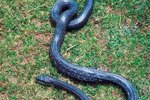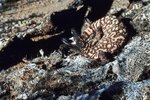
Nestled in the western United States in the middle of the Rocky Mountains, Wyoming has the lowest human population in the country. Much of its lush geography of plateaus, basins, lakes and rivers remains pristine and largely undisturbed. Fourteen species of snakes roam Wyoming's beautiful wilderness, but only two are considered dangerous.
Common Snakes
Topping the list of commonly found snakes in Wyoming are four garter snake species: the intermountain wandering, red-sided, valley and plains garter snakes. These live-bearing reptiles can be found near permanent water sources in the plains, mountains, sandhills and grasshills of Wyoming. Other species commonly occurring are the bullsnake, eastern yellow-bellied racer, plains hog-nosed snake and plains black-headed snake.
Rarely Encountered
Snakes rarely seen in Wyoming include the northern rubber boa, smooth green snake, Black Hills red-bellied snake, pale milk snake and Great Basin gopher snake. Although each of these slithering serpents is capable of delivering a painful bite if threatened, none are venomous. The northern rubber boa and Black Hills red-bellied snake reside under logs and flat rocks near water sources. The smooth green snake seeks areas with lush vegetation, and the Great Basin gopher snake prefers a drier sagebrush or desert environment.
Venomous Snakes
According to the Wyoming Game and Fish Department, two species of venomous snakes occur in Wyoming. The prairie rattlesnake is common and can be found in the foothills, scarp woodlands and plains. It preys on other reptiles and large rodents like rabbits and prairie dogs. The rare midget faded rattlesnake inhabits a restricted area in the southern part of the state, primarily in sagebrush desert communities and rock outcrops. Although little is known about its food sources, it's presumed to be similar to the prairie rattlesnake.
Snakes and You
According to the Humane Society of the United States, most snakes are not aggressive and cause relatively few problems for humans. Ecologically speaking, snakes benefit the environment by controlling insect and rodent populations. If you see a snake, leave it alone but attempt to identify the species from afar. If you identify a venomous snake, notify your local animal control, police or fire department so it can be removed.
References
Resources
Photo Credits
-
Visage/Stockbyte/Getty Images
Writer Bio
Yvette Sajem has been a professional writer since 1995. Her work includes greeting cards and two children's books. A lifelong animal advocate, she is active in animal rescue and transport, and is particularly partial to senior and special needs animals.




